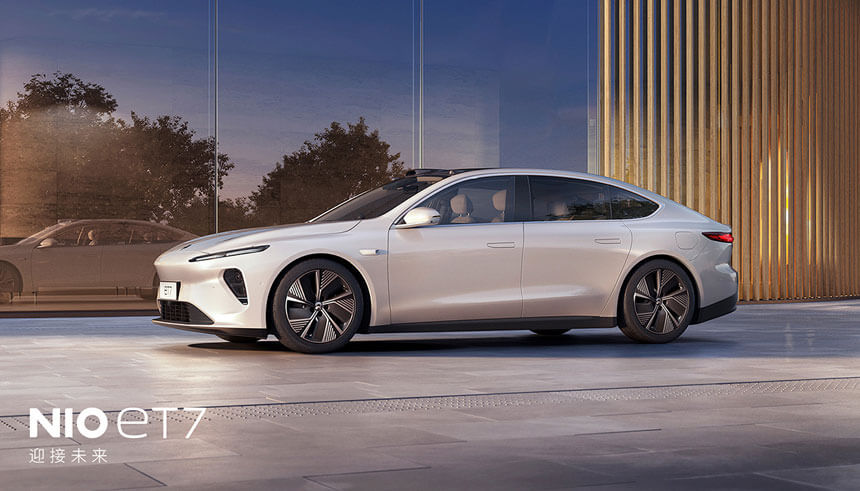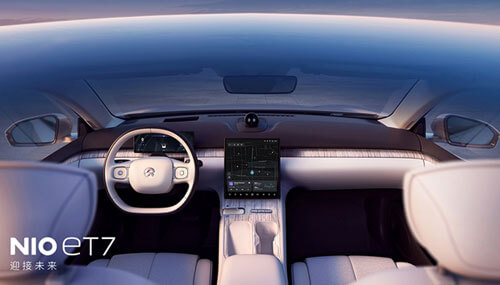U.S.-Asia Business
China's Global EV Revolution
By Daniel Allen

Chinese carmakers are betting on electric vehicles to transport them toward a bright new future.
China has a hugely impressive track record of industrial development over the last two decades, closing the gap with the West in a wide range of sectors. But despite massive funding and political support from Beijing, the country's carmakers have never really come to grips with the art of making high-quality internal combustion engine (ICE) vehicles. A lack of homegrown competition has seen Western brands, such as GM and Volkswagen, dominate Chinese sales since the 1990s, transforming the country into the world's largest and most lucrative auto market.
Today, the rise of the electric vehicle (EV) and associated technology promises to end this period of hegemony. Over the last few years the Chinese government has spent billions supporting Chinese EV makers and suppliers, creating the world's largest EV market and an unrivalled domestic charging infrastructure. With increasingly cutting-edge Chinese EV models now rolling off the production line, Western carmakers are rapidly facing a new reality.
"In the past, the fundamental assumption of Western carmakers was the same as other multinationals—that they would come to China, set the market for products, and China would come to them," says China automotive expert Bill Russo, founder and CEO of Shanghai-based strategy and investment advisory firm Automobility. "This might have worked during China auto 1.0.—but we're no longer in 1.0. The game has changed."
A shifting dynamic
The Chinese government, which views the EV industry as strategically important to China's future development, has declared that by 2035 all new car sales in China must be either full EVs or hybrids (collectively known as new energy vehicles, or NEVs). With China's increasingly stringent vehicle emissions standards kicking in, this is an eminently achievable target.
"Over the next five to eight years, a vast number of ICE vehicles that cannot meet these standards will be phased out and need to be replaced," says Kelvin Chan, managing director of East West Bank’s technology and cross-border division. "This creates huge opportunities for the EV sector."
With EV sales continuing to surge, Chinese brands are now dominating the electric vehicle market, boasting an 80% share in the first quarter of 2021.
"In May 2021, sales of plug-in EVs accounted for 12% of all car sales in China," says Russo. "I wouldn't be surprised if we saw that number reach 20% by next year, and at least 60% by 2030."
On the back of this trend, Russo sees the whole Chinese auto market dynamic changing: "At the moment, more than 60% of all new passenger vehicles sold in China are made by multinational brands. Fast forward to 2030, I think we'll see Chinese brands accounting for 60%. And within that 60%, Chinese brands are going to have 90% of the EV market. They're going to own the EV space within the larger share of the pie."

"Over the next five to eight years, a vast number of ICE vehicles that cannot meet these standards will be phased out and need to be replaced… This creates huge opportunities for the EV sector."
Understanding the market
Despite the onset of China auto 2.0, Western car manufacturers continue to see lucrative opportunities in China, with many ramping up local production of their own electric vehicles. Tesla's Model 3 plant in Shanghai, which opened in 2020, has the capacity to produce 250,000 cars a year, while VW and its Chinese partners started production at two factories in 2020 with a total potential annual output of 600,000 EVs a year. Ford will begin China-based production of its Mustang Mach-E later this year.
International original equipment manufacturers (OEMs) retain many advantages over their Chinese competitors and have a long record of producing quality vehicles. Nevertheless, China's rapidly evolving EV market poses a number of challenges. Many Western carmakers have been slow off the mark in understanding the need for producing EVs, while Chinese OEMs also have a headstart because they are better placed to understand Chinese consumers.
"Any Western carmaker operating in the Chinese market without offering an EV is going to find their sales increasingly pressurized," says Russo. "In China the opportunity for growth in ICE vehicles is essentially gone. This is why companies, such as GM and Volkswagen, are now investing so heavily in EV development.
Russo adds, "My fear is that many Western multinationals have entered China's EV market late, and having got in late, they have then proceeded to make fundamental errors. They are making the assumption that the same customers who would have bought their ICE vehicles in the past are going to be the ones convinced to buy an EV now. However, what we're seeing in China is not just a secular shift in EV, but a generational shift too. Younger buyers are coming in expecting affordable new technology—this is where much of the growth is."
Demographic shift
The story of the Hongguang Mini typifies Russo's point. Sales of the budget EV, which costs $4,500 and is produced by the SAIC-GM-Wuling Automobile Company (a joint venture between SAIC, Guangxi Automobile Group and GM) have soared over the last year, outstripping those of Tesla and every other EV carmaker. With 270,000 cars snapped up by Chinese buyers in the first nine months of production, the company is aiming to shift a staggering 1.2 million of the pint-sized, cost-effective vehicles in 2022.
"The scale of the lower-tier EV market in China is already sizeable," says Russo. "In Chinese regions where consumers don't have reliable public transportation, people are increasingly opting for a personally owned EV at a low price point. As the Hongguang Mini and other cars, such as Great Wall's Ora have shown, companies who cater to this market successfully will sell tons of cars. They're already doing it."
Russo sees a highly segmented Chinese EV market rapidly developing. "There's going to be two discrete tiers in China,” he explains. “A lower tier of affordably priced, youthfully styled vehicles for younger buyers, and an upper tier of vehicles aimed at family-oriented, upwardly mobile professionals—people who are going to buy the NIOs, the Xpengs and the Li Autos.”
Russo adds, "The Chinese understand the demographic shift to younger buyers who are considering technology and the bragging right of an EV. They're the ones to target. The multinationals don't get that. They come in with the idea that EVs are premium and that they have to be priced higher. What they're going to find is that they're squeezing themselves into a narrow segment of people who are not really interested in buying an EV. Volkswagen is discovering that already, with NIO outselling them three or four times."
Sales of Volkswagen's EV models in China have indeed been poor. Company figures show just 12,000 EVs were delivered to Chinese customers in the second quarter of 2021—this is around 10% of the company's global EV sales and less than half of the 28,000 cars Tesla sold in China in June alone. VW chairman Herbert Diess has called for the company to change the way it approaches EV sales in China, citing the fact that Chinese EV buyers are "much younger and different" from the company's existing customer base.
Tech-driven development
Thanks to massive levels of investment, a wide range of Chinese companies—many just a few years old—are now releasing competitive EVs on to the Chinese market.
"Many Chinese OEMs, regardless of whether they are newcomers or well-established, view the current EV trend as a critical opportunity to reshape China's automotive industry," says Ron Zheng, head of China automotive practice for Roland Berger. "These companies are spending huge sums of money to enhance product performance and build a customer base."
The design of electric vehicles has gone some way to levelling the international playing field for Chinese EV makers. Electric cars have far fewer components than ICE vehicles, which means it takes fewer resources to conceive and build them. That frees up time and money to develop and apply cutting-edge technologies, such as autonomous driving and artificial intelligence. NIO's cars, for example, have NOMI, the world's first in-vehicle AI, which now boasts over 200 million human interactions.
"If you compare the technology and performance of Chinese EV products with the rest of the world, the gap is far smaller than it is in ICE products," says Zheng. "This is partly attributable to a global supply chain and the emergence of Chinese EV supply giants, such as leading battery maker CATL."
Founded in 2011, Ningde-based CATL (Contemporary Amperex Technology Ltd.) has rapidly risen to become the world's largest battery maker, with a market value of $200 billion. Powered by CATL's cutting-edge solid-state 150-kilowatt-hour batteries, NIO has announced that its ET7 sedan, which will hit the Chinese market in early 2022, will have a record-breaking range of over 1,000 kilometres.
The people perspective
Chinese EV makers are also revolutionizing the mobility experience. NIO, for example, boasts an ever-growing range of NIO "Houses," which act as both a showroom and as a social space for NIO car owners. Facilities include coffee shops, daycare centers, libraries and meeting spaces.
"Usually, the relationship between the carmaker and customer ends at the point of purchase," says JoAnn Yamani, director of NIO's U.S. communications. "At NIO, we want our users to become part of a community."
NIO is also well known for its unique Battery-as-a-Service (BaaS) business model, which allows customers to buy a cheaper EV without a battery. Customers can instead rent batteries monthly, with the ability to swap between batteries of different sizes and range. Battery swapping allows drivers to rapidly exchange their depleted battery for a fully charged one at specially equipped service stations. By 2025, NIO is aiming to have more than 4,000 such stations in operation, including around 1,000 outside of China.
Overseas expansion
Having innovated and built market presence in China, a growing number of Chinese EV manufacturers are casting their eyes further afield. Chinese carmakers have long struggled to establish themselves in developed markets, but are now looking to leverage an improving perception of Chinese products, as well as burgeoning demand from European consumers for affordably priced EVs with decent range and cutting-edge tech. In 2020, 23,800 Chinese EVs were sold in Western Europe, up 1,290% from the year before, according to a report by Berlin-based Schmidt Automotive Research.
"It is important for Chinese EV OEMs to take the opportunity to move into overseas markets," says Zheng. "Not only for sales growth, but also in terms of building their brand and business, storytelling and learning valuable lessons."
At the beginning of May, NIO announced its intention to enter the Norwegian market—the company's first foray overseas. It plans to build a complete ecosystem that includes services, cars, lifestyle, digital experience and an EV owner community. The NIO ES8 SUV, the flagship NIO model, will arrive in Norway later this year, followed by the ET7 sedan in 2022.
NIO will directly build its sales and service networks in Norway. The first NIO House outside of China will officially open in the third quarter of 2021 in Oslo, followed by four NIO Spaces (essentially an upmarket showroom) in Bergen, Stavanger, Trondheim and Kristansand in 2022. The first deliveries of battery chargers and exchange stations are also on their way to the country.
Norway's soaring demand for electric vehicles makes it highly attractive for Chinese carmakers looking to enter the European market. In June 2021, plug-in cars accounted for nearly 85% of all new car sales in Norway. The country will stop all new ICE vehicle sales by 2025, with the Norwegian government rolling out a hefty package of incentives developed to promote zero-emission vehicles. These include exemption from purchase taxes and 25% VAT, which makes EV prices comparable with those of ICE vehicles.
In addition to NIO, Xpeng Motors has been selling cars in Norway since December 2020, while Hongqi's upmarket E-HS9 is also on sale. BYD, the Chinese automaker backed by American business magnate Warren Buffett, shipped its first 100 European-specification Tang SUVs to Norwegian dealers in June and aims to deliver 1,500 by the end of the year.
While NIO's second European market remains unconfirmed, the company's European vice president Hui Zhang has hinted that Germany's mature EV market and infrastructure could make the country a strong contender. Regardless of where NIO goes, China EV makers are primed for global growth.


